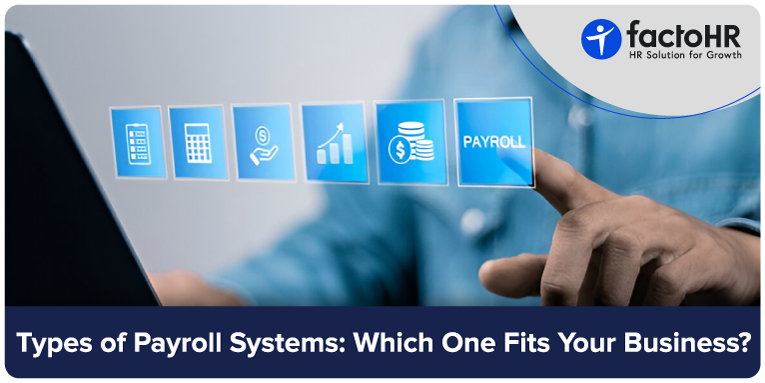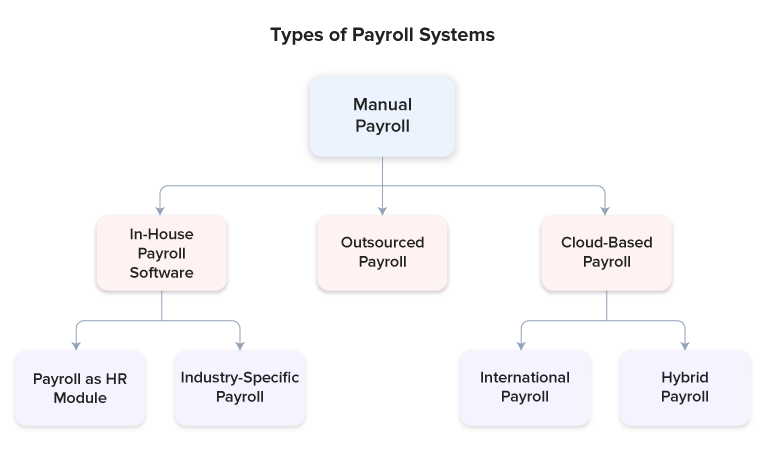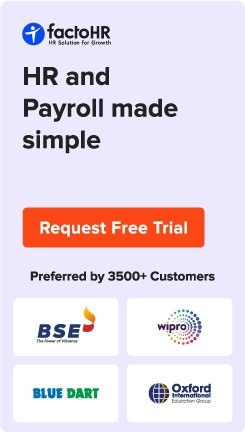Types of Payroll Systems: Which One Fits Your Business?

Table of Contents
Payroll management processes, such as distributing salaries and maintaining employee records, can be traced back to the 14th century. However, the unprecedented proliferation of payroll management systems has automated nearly all payroll-related processes, thereby streamlining manual tasks.
Statistically, the payroll market is estimated to be worth around $65.66 billion by 2029. This finding makes a compelling case for investing in payroll services.
Payroll systems are primarily important because they simplify payroll management by automatically calculating various salary components and by streamlining other processes such as compliance management. Subsequently, such software also improves employee satisfaction, as employees receive timely payments with these systems.
Organizations process payroll in various ways. Some organizations outsource payroll as a service. Others rely on cloud-based softwares. While some small businesses still manage payroll manually.
This blog outlines the various types of payroll systems and highlights key factors to consider when selecting a payroll management system.

What are the Main Types of Payroll Systems?
The main types of payroll software include manual payroll, in-house payroll software, cloud-based payroll, and outsourced payroll. There could be other types of payroll as well, such as payroll as an HR module, industry-specific payroll, and international payroll.

Manual Payroll
In this type of payroll, organizations use spreadsheets to perform payroll-related functions. The functions include entering data related to time of and attendance, calculating salary components, settling claims, and adjusting for tax deductions.
Manual payroll is cost-effective. It also offers total control over all aspects of payroll management. However, it is known to be error-prone, as manually entering data could lead to data inconsistencies. Manual payroll processing could also lead to issues related to data migration and data fragmentation, as all processes are performed in silos. Regardless, manual payroll could be a solution for small businesses with 1-10 employees.
In-House Payroll Software
Such softwares can be installed on internal servers. In-house payroll software has several benefits. It minimizes errors by automating most repetitive tasks. Also, they offer greater control over data privacy and security. On the other hand, users need to be tech-savvy to use in-house payroll solutions.
Additionally, you may incur higher costs, as in-house payroll software is a license-based solution and has a higher upfront cost compared to digital solutions. Updating an in-house payroll software would also be difficult. Moreover, integrating in-house software with an HR module would be challenging and could lead to more errors.
Regardless, small and medium-sized businesses could still consider it as one of the available solutions.
Cloud-Based Payroll
Cloud-based payroll software is one of the popular solutions. The digital industrial revolution has almost made it a priority for organizations.
A cloud-based payroll system is advantageous for your business for a number of reasons, like –
- Complete automation of payroll processes with automatic tax deductions and automated calculations of salary components.
- On-the-go access to payroll information.
- Self-service features include viewing and downloading tax declarations.
Cloud-based payroll software could make a difference for small, medium, and large businesses. It is also suitable for firms operating in multiple regions.
Outsourced Payroll
In outsourced payroll, organizations rely on a 3rd party provider for performing various payroll processes. A third-party vendor manages processes such as salary distribution and tax compliance. The provider also keeps records and makes sure that organizations adhere to their respective regional regulations.
Startups and small businesses with 50-100 employees could save costs by outsourcing payroll.

Payroll as an HR Module
Payroll, as an HR module, has become more popular following the widespread adoption of HRMS systems. This type of payroll software is integrated with performance, leave, attendance, and time-tracking modules. Such integration helps in optimizing payroll processes.
Employers would be able to:
- Track attendance and time of,
- Calculate leave balance, and
- Reward high performers with performance-based incentives.
Integrating payroll with HR modules can be advantageous for all businesses, regardless of their size or sector.
Industry-Specific Payroll
An industry-specific payroll software is designed to address specific issues faced by an industry.
These systems offer different features that are useful for different industries. For example, a solution that is specifically designed for healthcare would focus on shift management and similar features. On the other hand, a software developed for IT and similar sectors might lean more towards features like online access and digital payroll processes.
International Payroll
Cross-border payroll management and related features are emphasized in international payroll. Features offered by an international payroll system can significantly improve compliance with global/regional regulations related to payroll.
International payroll softwares provides features like –
- Real-time updates about global regulations such as minimum wage laws, tax regulations, data privacy laws, and laws related to employee classification.
- Payments in multiple currencies, and
- Ready-to-file tax reports.
Such payroll systems are ideal for multinational firms.
Hybrid Payroll
In a hybrid payroll, employers rely on partial payroll outsourcing.
- In partial payroll outsourcing, some of the payroll processes are handled by PEOs and other payroll service providers.
- At the same time, the employer administers other components of payroll management.
For example, compliance management and tax calculations may be handled by a third-party provider, while the business typically manages routine tasks such as tracking leave balances.
This type of payroll method could benefit medium-sized enterprises.

How to Choose the Right Payroll System for Your Business
Here are the factors to consider when choosing a payroll system:
- Company size and workforce location,
- Budget and technical expertise,
- Compliance needs, like local, state, national, or global,
- Integration with HR and accounting systems,
- Scalability and future growth, and
- Self-service and reporting features.
Assess Your Company Size, Industry, and Workforce Location.
Different types of payroll systems are suitable for various business sizes and sectors. For example, an in-house payroll software would be ideal for medium- to large-sized enterprises.
Opt for a solution that offers industry-specific features and functionalities tailored to the company’s needs. For example, a healthcare facility would benefit from a solution that provides shift management and safety compliance features.
Organizations should also think about the location of their workforce. Selecting payroll software, whether cloud-based or on-premises, based on specific requirements, is beneficial in the long term.
Determine Your Budget and In-House Expertise.
Companies should weigh the costs against the return on investment (ROI) when considering different payroll systems. For example, an HR payroll module might be more cost-effective than a standalone payroll software.
Employers and HR managers should also be aware of the technical complications when choosing a type of payroll. An in-house payroll software is more complex than cloud-based payroll software.
Consider Compliance Needs (Local, State, International).
Complying with labor regulations is the most critical aspect of payroll management. Based on the location of the company, it would need to comply with different laws. Therefore, opt for a payroll system that offers compliance features tailored to your company’s specific needs.
Evaluate Integration with Existing HR/Accounting Systems.
A recent study found that only 41% of employers were satisfied with their integration capabilities. This finding emphasises the need to integrate HR with payroll. Integration between existing HR facilities and payroll modules would streamline the payroll processing. It would do so by automatically collecting and entering data related to attendance, leave, work hours, and performance reviews. So, opt for a solution that easily integrates with HR and accounting systems.
Prioritize Scalability and Future Growth.
Prefer a solution that can accommodate a growing workforce, as the workforce will inevitably expand alongside any organization, regardless of its size.
Check for Employee Self-Service and Reporting Features.
Self-service features are gaining traction due to more impetus to employee satisfaction. Some common self-service features include real-time access to payroll related information and downloadable payslips. Features like payroll dashboards and reports are also becoming increasingly important, as organizations are relying on data to make decisions related to workforce management. These reporting features also help in compliance and in creating a transparent environment.

Conclusion
This blog explained the different types of payroll systems. HR leaders should be able to opt for the right payroll solution for their businesses. As mentioned, factors such as the size and location of your firm, your technical expertise, and affordability are important considerations when selecting a payroll management system.
Consider value-for-money options like factoHR and similar solutions. They offer features like comprehensive payroll reporting, integration with HR and accounting systems, automated tax compliance, and simplified salary processing, among others.
Evaluate the available and affordable options and book a demo with your chosen solution for managing payroll.
Grow your business with factoHR today
Focus on the significant decision-making tasks, transfer all your common repetitive HR tasks to factoHR and see the things falling into their place.

© 2026 Copyright factoHR


